Services on Demand
Journal
Article
Indicators
-
 Cited by SciELO
Cited by SciELO -
 Access statistics
Access statistics
Related links
-
 Cited by Google
Cited by Google -
 Similars in
SciELO
Similars in
SciELO -
 Similars in Google
Similars in Google
Share
Boletín Científico. Centro de Museos. Museo de Historia Natural
Print version ISSN 0123-3068
Bol. Cient. Mus. Hist. Nat. Univ. Caldas vol.16 no.2 Manizales July/Dec. 2012
"ALGUNOS ASPECTOS DE LA BIOECOLOGÍA DE LA CIGUA CITTARIUM PICA (MOLLUSCA: GASTEROPODA) EN EL DARIÉN CARIBE COLOMBIANO"
* FR: 12-IX-2011. FA: 10-V-2012.
1 Corporación Académica Ambiental, Doctorado en Ciencias del Mar. Universidad de Antioquia. E-mail: tatimares@hotmail.com
2 Departamento de Ciencias Biológicas, Universidad de Caldas. E-mail: beatriz.toro@ucaldas.edu.co
3 Departamento de Antropología, Universidad de Antioquia. E-mail: javier.rosique@siu.udea.edu.co
The bioecology of West Indian topshell (Cittarium pica) was studied in the Colombian Caribbean Darien, sampled monthly for a year at four stations located on the rocky coastline of Capurganá and Sapzurro in the municipality of Acandí. Physicochemical variables were recorded, density and size distribution in the gastropod. Additionally, five individuals were collected to determine the reproductive state, proportion of sexes and minimal sexual maturity size. It was found that the abundance is positively related to the salinity gradient; the average density was 5.4 ± 6 individuals/m². The majority of individuals were classified in the smallest sizes being 79 mm shell width the maximum size. C. pica reproduced continually with a spawning peak in September (wet season). The population showed a normal sex proportion (1:1) and a minimum sexual maturity of 29 mm. The population studied is affected by natural factor such as temporary freshwater inputs. It also presents evidence of overexploitation as they found few individuals of large size. Additionally, in September and October time which present the largest spawning of C. pica, is celebrated The Cigua Festival (a traditional festivity in Capurganá) brings with itself a massive fishing of this snail for consumption and marketing.
Key Words: Bioecology, West Indian topshell, Cittarium pica, gastropod, Caribbean Darien, Colombia.
Resumen"Se evaluó la bioecología de la Cigua o Burgao (Cittarium pica) en el Darién Caribe colombiano, realizando muestreos mensuales durante un año en cuatro estaciones ubicadas en el litoral rocoso de los corregimientos de Capurganá y Sapzurro en el municipio de Acandí. Se registraron variables fisicoquímicas, densidad y distribución por tallas del gasterópodo, adicionalmente se colectaron cinco individuos para determinar el estado reproductivo, proporción de sexos y talla mínima de madurez sexual. Se encontró que la abundancia está relacionada positivamente con el gradiente de salinidad, la densidad promedio fue de 5.4 ± 6 individuos/m², la mayoría de los individuos presentan tallas pequeñas y el máximo tamaño fue de 79 mm de amplitud de concha. Cittarium pica se reprodujo continuamente, con un pico de desove en septiembre (época húmeda) y la población presentó una proporción de sexos 1:1 con una talla mínima de madurez sexual de 29 mm. La población estudiada es afectada por factores naturales como eventuales aportes de agua dulce. Además, presenta evidencia de sobreexplotación, ya que se encontraron pocos individuos de tallas grandes. Adicionalmente, en septiembre y octubre época en la cual se presenta el mayor desove de C. pica, se celebra el Festival de la Cigua (fiesta tradicional en Capurganá) el cual produce una mayor pesca de este caracol para su consumo y comercialización".
Palabras clave: Bioecología, Cigua, Cittarium pica, gasterópodo, Darien Caribe, Colombia.
West Indian topshell (C. pica) is a marine gastropod that suffering a large artisanal fishing due to its tasty meat, large size and easy access to its habitat in the rocky shoreline. It is considered the second marine topshell with bigger fishing in the Caribbean after the queen conch Strombus gigas (RANDALL, 1964), and Colombia is categorized as vulnerable species in the Red Book of Marine Invertebrates of Colombia (ARDILA et al., 2002).
The bioecology of the gastropod was studied in the Virgin Islands (RANDALL, 1964; TOLLER & GORDON, 2005), Venezuela (FLÓREZ & CACERES, 1981; CASTELL, 1987), Bahamas (DEBROT, 1990a; 1990b), Costa Rica (SCHMIDT et al., 2002) and Colombian Caribbean (OSORNO & DIAZ, 2005). BELL (1992) studied its reproduction and larval development and GRAHAM (1965) made observations of the species anatomy.
According to OSORNO & DIAZ (2005), the second biggest fishing pressure of the West Indian topshell in the country is found in the Colombian Caribbean Darien (Capurganá and Sapzurro), highlighting that the "Cigua Festival" is held in Capurganá in October every year, time by which the intensity of the waves reduces, which permits the easy access to people to the rocky coastline. Taking into account the ecological and socioeconomic importance of the gastropod and its vulnerability to extinction, some bioecologic aspects were evaluated that allow taking measurements of use and sustainable managing of the resource by local fishermen.
MATERIALS AND METHODSThe study was carried out in Golfo de Urabá, covering about 6 km of the coast between Capurganá and Sapzurro in the municipality of Acandí, department of Chocó (Figure 1), between 08º30'00'' N and 77º30'00'' W (El Aguacate) and 08º40'00'' N and 77º21'32'' W (Cabo Tiburón). Field work was conducted at four sites: El Aguacate, La Diana, and Punta Ruben, which are composed of bioclastic coral structures of slight slopes in the mesolittoral and rough slopes in the upper infralittoral, with protected coastlines and regular intensity waves. La Coquerita Station is found in the mid part of a long coastline exposed to waves, composed of marine igneous volcanic rock that shows variable slopes (M. T. FLÓREZ, Com. Pers.)
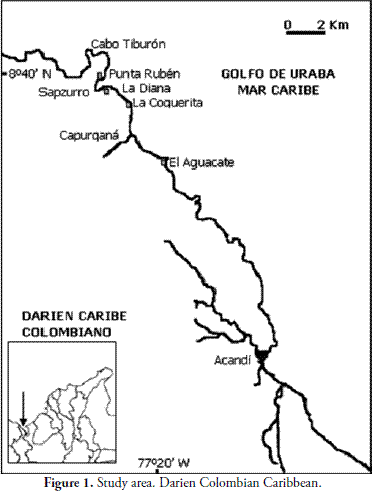
Samples were collected monthly between September 2004 and 2005 in the infralittoral zone and upper mesolittoral that correspond to the species habitat. In each station was recorded surface water temperature, pH and salinity with a hand refractometer. In the mesolittoral was established transect of 20 m in length and four 1 m² quadrants were located every 5 m. In each quadrant all the individuals of the C. pica were captured without considering their size, to measure and release them. For the reproductive study, five topshells with different sizes were collected at random, in order to obtain a statically representative sample and produce the least possible impact due to the removal. Finally, a sample of algae was collected (green, red, brown, and calcareous) and which was associated to the extracted ones for a posterior taxonomic determination.
The growth rate was evaluated monthly for one year. Individuals were marked on the outer lip of the shell with epoxy paint, and in its inner with pencil. Each month it was measured the amplitude of the shell of individuals recaptured and continued doing the marking of new individuals.
Some aspects of the bioecology of the west indian topshell Cittarium pica 165 Abundance and density for C. pica was compared between sampling stations using The Mann Whitney U test, and used the Spearman and Pearson correlation to find associations between them and physicochemical variables.
Each specimen was measured the width of the shell and the average size was compared among sampling stations. Four size intervals were defined (1-19, 20-39, 40-59, 60-79 mm shell width). The relative frequency for each one was determined and the distribution by sizes through time in each sampling station was compared. The Mann Whitney U test was performed to find significant differences in the size distribution between sampling stations.
The sexing of mature specimens was done by visual inspection of gonad and according to its color (RANDALL, 1964); cream indicates that it is a male and green that it is a female. The Mann Whitney U test was used to compare the sex ratio among the sampling stations. The rate of filling and maturity of the gonad was made qualitatively by two smear of its and checking under the microscope. Four maturity stages were established taking into account the criteria aforementioned as well as the size of the individuals.
Immaturity: the gonad shows a grey or brown color and the individual do not surpass the 33 mm shell width. For size was taken into account the minimum size of sexual maturity found by RANDALL (1964).
Maturity: the gonad shows a filling percentage of 70%.Reproductive: the filling percentage of the gonad goes between 70% and 100%.
Spawning: animals that are not filled the gonad and exceed 33 mm shell width.The number of individuals was compared in each maturity stage through time and in each sampling station. The U de Mann Whitney test was carried out to know the significant differences among the stations and the Spearman and Pearson correlation to know the associations among them as well as the physicochemical variables. Lastly, the minimum sexual maturity size was calculated based on the individuals in the maturity and reproductive stage according to SCHMIDT et al. (2002).
Where:
Xk = Constant equal to 3.829
X = Average lnMli+1-lnMi
Mli = mark of size class (mm)
Mi = Number of mature individuals at 100%
Pi =Mi/Ni
Ni = Number of individuals with size is between a class mark and the next.
Algaes: Three species of common algaes were found in all the stations, two belonging to the Rhodophyta (Laurencia papillosa and, Polysoma sp.) and one Phaeophyta (Sargassum cymosum). La Coquerita station showed the least algaes variety. Ciguas: 829 C. pica individuals were collected, finding the least quantity (148) in El Aguacate and the most (270) in La Diana. Between September and November 2004, the biggest quantity of C. pica was found. A positive Spearman correlation was observed with salinity rho=0.50; p=0.001.
The average density was 5.4 ± 6 individuals/m²; the highest (21.7 ind/m²) showed in October 2004 at La Diana Station, the lowest (0.5 ind/m²) was recorded in June and July 2005 at el Aguacate and in July at La Diana (Figure 2). Significant differences were found in the density values between El Aguacate and Punta Ruben stations (Z= -2.63; p= 0.009) and between La Coquerita and Punta Ruben (Z= -2.05; p= 0.04).
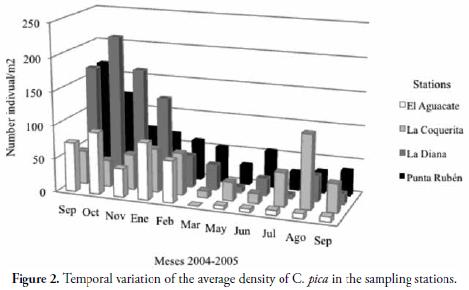
The recapture of marked individuals was very low. At the station La Coquerita were collected 520 individuals among which 48 were recaptured and only 22 of these showed consistent data. At the station Punta Ruben were collected 652 snails of which 114 were recaptured. The average monthly growth increase was 3 mm for snails from the station La Coquerita and 2 mm for those of Punta Ruben station.
Individuals with a shell width of 1 and 79 mm were found, and a mode of 4 mm and an average of 21 mm were observed. El Aguacate and La Coquerita stations showed the highest medium sizes (33 ± 15 and 25 ± 14 mm respectively), while in La Diana and Punta Ruben, the sizes were the lowest (15 ± 13 and 16 ± 15 mm respectively).
Some aspects of the bioecology of the west indian topshell Cittarium pica 167 Regarding the size intervals, 55.9% of the individuals were in the 1-19 mm shell width interval, 32.6% in 20-39 mm, 8.6% in 40-59 mm, and 2.9% in 60-79 mm. Most of the individuals in the first interval were collected between September and November 2004, while those in the last interval were collected between March and September 2005 (Figure 3).
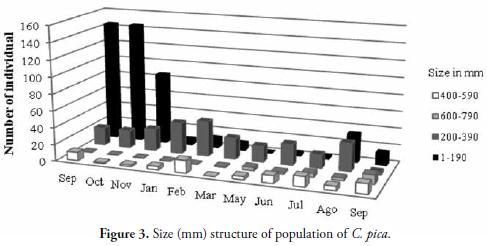
In El Aguacate and La Coquerita, the largest quantity of individuals was between 20 and 39 mm, while in La Diana and Punta Ruben they were between 1 and 19 mm. The least abundance of individuals between 60-79 mm was found in all the stations (Figure 4). The most significant differences were found in the sizes 40-59 mm in El Aguacate and Punta Ruben stations (Z= -2.04; p= 0.04).
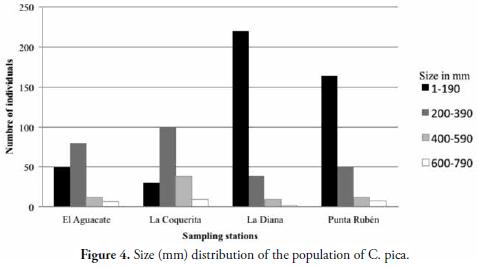
145 individuals were sexed, finding a normal proportion of 1:1. The majority of them were in the reproductive stage (48.3%) and the minorities were in the spawning phase (4.7%). Individuals in the maturation and reproduction stages were found in almost all the samples, while in spawning there were collections only in September, November, February, March and June. The immature were found between February and June (Figure 5). Punta Ruben station showed the biggest homogeneity in the maturity stage distribution.
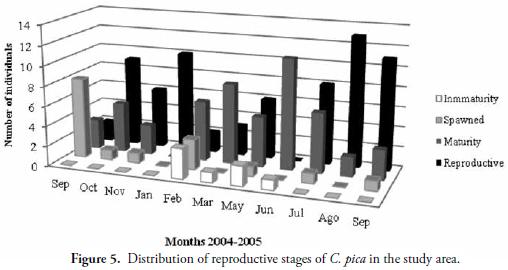
Significant differences were found among the quantity of individuals in the reproductive stage between El Aguacate and Punta Ruben stations (Z= -2.45; p= 0.004), in the spawning stage between the same stations (Z= -2.45; p= 0.02), and between La Coquerita and Punta Ruben (Z= -2.24; p= 0.03). An inverted correlation was observed between the temperature and the maturity stage (rho = -0.526; p= 0.01). Finally, a minimum sexual maturity size of 29.2 mm was calculated (Table 1).
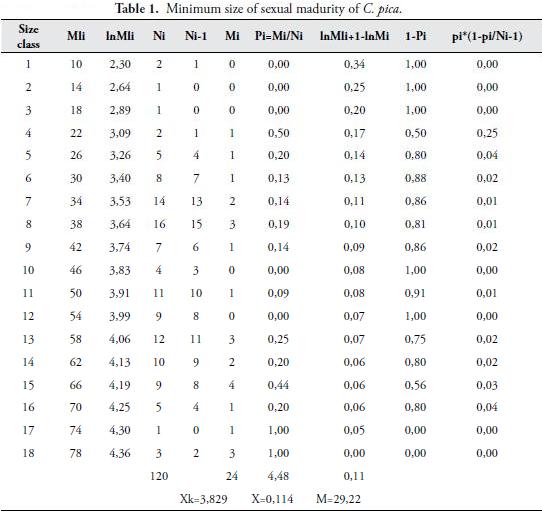
Where:
Mli = mark of size class (mm)
Ni = Number of individuals with size is between a class mark and the next
Mi = Number of mature individuals at 100%
Xk = Constant equal to 3.829
X = Average lnMli+1-lnMi
M = Minimum size ofsexual maturity (antilog of m)
Ln m = Xk - x/2 - (X*∑ Pi)
In La Coquerita station were observed a fewer varieties of algaes, probably because it was more exposed to the waves. Among the species that were registered, only Polysiphonia sp. was reported as food for C. pica by RANDALL (1964) and CASTELL (1987). However, it is important to conduct a comparative analysis of food availability and diet of this gastropod in the Colombian Darien to identify algae species important in the diet of this gastropod in this area.
The direct relation between the abundance of C. pica and the salinity gradient is corroborated when finding the least abundance in El Aguacate station which is located southern, and, therefore, closer to the Atrato and other rivers mouths, and the biggest abundance shown in La Diana and Punta Ruben stations, located northern.
The biggest density was recorded in October when recruitment was observed (ind < 2 mm). The smallest density was found after March, when there was a fresh water phenomenon and no individuals were found in el Aguacate station. The average density shows a big standard deviation (5.4 ± 6 ind/m²) due to the big data variability related probably to the fresh water effects and the massive extraction of the topshell as a consequence of the Cigua Festival.
Regarding the reports by other authors, the highest density found by CASTELL (1987) was 6.1 ind/m² and the lowest 0.7, while DEBROT (1990a) found the highest in 8.4 ± 1.0, and the lowest in 4.3 ± 0.4. In another work carried out by DEBROT (1990b), the highest density (4.3 + 0.4 ind/ m²) was found in a place exposed to the waves and the lowest (1 ind/ m²) in another protected site. On the other hand, SCHMIDT et al. (2002) found 3 ind/ m² in an exploited site and 14 in a nonexploited site.
The significant differences (p < 0.05) among the density values between El Aguacate and Punta Ruben stations and between La Coquerita and Punta Ruben stations can be attributed to the fact that El Aguacate station was the most affected and which recovered more slowly after the fresh water current and that in La Coquerita station the sampling was difficult to collect due to the big waves the cost was exposed to, generating thus a slant in the data.
The maximum and medium sizes (21 and 79 mm respectively) of C. pica in the study area are considered small taking into account that the species reaches sizes bigger than 100 mm in other regions of the Caribbean. RANDALL (1964) found in the Virgin Islands a maximum size of 100 mm, CASTELL (1987) in Venezuela a size of 120 mm and OSORNO & DIAZ (2005) registered in the Colombian Caribbean a maximum size of 105 mm and a medium size of 25 mm and in the Darien a maximum size of 68 mm and a medium size of 17 mm.
It was found that 88.5% of the individuals collected corresponded to small sizes between 1 and 40 mm shell width, a similar report by OSORNO & DIAZ (2005). According to DEBROT (1990b) the lack of big sizes suggests high rates of extinction due to the low survival or to low growing rates. On his side, SCHMIDT et al. (2002) found a frequency in the small sizes significantly higher in places with a higher exploitation; in this case, the most probable is that there is a higher inshore fishing in the study area, taking into account that every October the people collect massively a C. pica in order to satisfy the demands for the Cigua Festival. According to OSORNO & DIAZ (2005) the Urabá is the second area with more risk of extinction in terms of quantity of C. pica caught presently in the Colombian Caribbean.
It is important to highlight that in the stations located in Sapzurro Bay (La Diana and Punta Ruben) a greater quantity of individuals between 1 and 19 mm and were found and a population structure in which it is seen a strong reduction of the bigger sizes (40-59 and 60-79), which may to indicate that there are phenomena that affect the survival of the individuals. On the other hand, La Coquerita station has a population structure in danger of extinction, since despite the 78% of the individuals who are in the reproductive stage (30-59 mm interval), only 17% are found in the pre-productive stage (01-19 mm), and 5% in the post-productive stage (60-79 mm). It is probable that the combined effects of freshwater input, wave exposure (TOLLER & GORDON, 2005) and overfishing are affecting the population of C. pica in the La Some aspects of the bioecology of the west indian topshell Cittarium pica 171 Coquerita and El Aguacate making it small size and low recruitment.
However, it must be taken into account that there are other cigua populations that are in a good state of conservation in the Panamá coastline limiting Colombia, reason by which it is probable that the water currents transport larvae to the Colombian Darien reducing the effects described already.
As in the study by CASTELL (1987), mature and reproductive individuals were found during all almost months that the study was carried out. The highest spawn peak in September coincides with a bigger amount of small topshells (1-19 mm shell width), which agrees with the results by OSORNO & DIAZ (2005). This result should be source of worry taking into account that it is during this month that fishermen collect most of the top shells in order to supply the demands of the Cigua Festival in October every year. It is suggested then to issue laws forbidding its fishing during September and October and to redirect the festival as a strategy for the conservation of the species.
The minimum sexual maturity for C. pica obtained by RANDALL (1964) was 33 and 34 mm for males and females respectively. SCHMIDT et al. (2002) found a minimum sexual maturity with an average of 29 ± 1 mm in the Caribbean coast of Costa Rica, and proposed a minimum fishing size of 40 mm. On the other hand, CASTELL (1987) argues that since 30 mm diameter, an individual can be sexually defined, but that even individuals with a 74 mm diameter may show a sexual immaturity. Therefore, he proposes a minimum fishing size between 70 and 75 mm diameter. OSORNO & DIAZ (2005) agrees with these results and proposes a minimum fishing size of 75 mm for the C. pica in the Colombian Caribbean. Taking the aforementioned into account and the results obtained in this study, it is proposed that the minimum fishing size for fishing be of 40 mm diameter.
ACKNOWLEDGEMENTSWe would like to thank the economic support received from the Committee for the Development of Research "Comité para el Desarrollo de la Investigación" (CODI), the Environmental Academic Corporation "Corporación Académica Ambiental" and the Dirección de Regionalización. The support of local researchers and of the communities of Capurganá and Sapzurro, as well as the research groups Environment and Society "Medio Ambiente y Sociedad" (MASO), Sustainable Development Group "Grupo de Desarrollo Sostenible (GDS), Management and Environmental Modeling Group "Grupo de Gestión y Modelación Ambiental" (GAIA), and the research line on Medical Malacology and Trematology of the Study Program for the Control of Tropical Diseases "Malacología y Trematología Médica del Programa de Estudio y Control de Enfermedades Tropicales (PECET).
BIBLIOGRAPHYARDILA, N.; NAVAS, G. & REYES, J. 2002.- Libro Rojo de los Invertebrados Marinos de Colombia INVEMAR / Ministerio del Medio Ambiente, Serie de Libros Rojos de Especies Amenazadas de Colombia, Bogotá D. C., Colombia, p.179 [ Links ] L. 1992.- Reproduction and larval development of the West Indian topshell, Cittarium pica (Trochidae), in the Bahamas. Bulletin of Marine Science, 51 (2): 250-266. [ Links ]
CASTELL, L. 1987.- Algunos aspectos de la biología y ecología de Cittarium pica (L.) "Quigua" (Prosobranchia, Trochidae), en el Parque Nacional Archipiélago de los Roques. Tesis Profesional de Biólogo, Universidad Central de Venezuela. Departamento de Ciencias Naturales, Facultad de Biología. Caracas (Venezuela), p.135 [ Links ] A. 1990a.- Temporal aspects of population dynamics and dispersal behaviour of the West Indian topshell, Cittarium pica (L.) at selected sites in the Exuma Cays, Bahamas. Bulletin of Marine Science, 47(2):431-437. [ Links ]
DEBROT, A. 1990b.- Survival, growth and fecundity of the West Indian topshell, Cittarium pica (Linnaeus) in various rocky intertidal habitats of the Exuma Cays, Bahamas. The Veliger, 33(4):363-361. [ Links ] [ Links ]
GRAHAM, A. 1965. Observations on the anatomy of some trochacean gastropods. Bulletin of Marine Science, 15 (21): 203-209. [ Links ] [ Links ]
RANDALL, H. 1964. A study of the growth and other aspects of the biology of the West Indian topshell Cittarium pica (Linnaeus). Bulletin of Marine Science, 14: 424-443. [ Links ] [ Links ]
TOLLER, W. & GORDON, S. 2005.- A population survey of the West Indian topshell or whelk (Cittarium pica) in The U.S. Virgin Islands. Department of Planning and Natural Resources. Government of the U.S. Virgin Islands. City (State) USA, p.17 [ Links ]













